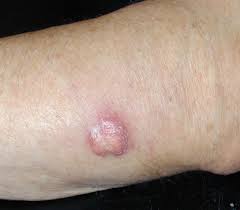
Squamous cell carcinoma (SCC) is a type of skin cancer that develops in the squamous cells that make up the outer layer of the skin. SCC can occur anywhere on the body, but it is most commonly found on areas of the skin that have been exposed to the sun, such as the face, neck, hands, and arms. Here are some key facts about squamous cell carcinoma:
Causes:
- Exposure to ultraviolet (UV) radiation from the sun or tanning beds is the primary cause of squamous cell carcinoma.
- Other risk factors include fair skin, a history of frequent sunburns, a weakened immune system, exposure to certain chemicals or toxins, and a history of previous skin cancer.
Symptoms:
- A firm, red bump or flat, scaly patch on the skin that may be crusty or bleed easily.
- An open sore that does not heal or heals and then returns.
- A growth that looks like a wart or raised, rough patch on the skin.
Diagnosis:
- A biopsy is the only way to definitively diagnose squamous cell carcinoma.
- During a biopsy, a small sample of the affected tissue is removed and examined under a microscope to determine if cancerous cells are present.
Treatment:
- Treatment for squamous cell carcinoma typically involves surgical removal of the cancerous tissue.
- Mohs surgery, which involves removing thin layers of tissue and examining them under a microscope until all the cancerous cells are gone, is a common surgical technique for treating squamous cell carcinoma.
- Other treatment options may include radiation therapy, topical chemotherapy, or immunotherapy.
Prognosis:
- Squamous cell carcinoma is usually curable when detected and treated early.
- If left untreated, squamous cell carcinoma can grow deeper into the skin and spread to other parts of the body, potentially becoming life-threatening.
